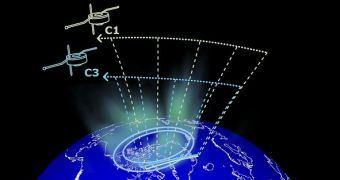Although the term “geomagnetic substorm” has been used in science-fiction movies and books, experts still have only limited amounts of information on the phenomenon. New studies are now trying to explain some of the factors that drive this process, but yet numerous holes remain in our understanding.
Earth physicists know that some bright polar auroral displays are caused by a sudden pulse of energy that simply becomes loose inside our planet's magnetosphere. This layer of the atmosphere usually protects us against the damaging effects of solar flares and cosmic radiation.
What is becoming increasingly clear is that systems analysis has not penetrated this area of research to a sufficient extent just yet. What this means is that scientists are still not viewing this issue from multiple angles at the same time.
The planet's magnetism and the connections that tie us to the Sun play equally important roles in what is going on high above the surface, as do radiation belts that surround Earth. To what extent each of these actors influence the overall behaviors of the magnetosphere is now still an unknown quantity.
Spacecraft constellations such as the European Space Agencys' (ESA) Cluster mission are slowly building up data on the phenomenon, but physicists admit their still have a lot to go before they can provide even a preliminary answer.
Cluster found that massive fluxes of electrons and protons produced by solar winds and coronal mass ejections are constantly bathing the magnetosphere in energy. Rarely, some of those radiations escape into the magnetotail, where they accumulate charge as if in a battery.
When certain thresholds are triggered, that charge snaps, rearranging Earth's magnetic field lines, and draining along them to create stunning aurora displays. While this much is established, figuring out the exact origins of such a storm has proven to be a tricky task.
Sudden disruption of electric current about 64,000 kilometers away or magnetic reconnections happening 125,000 to 200,000 kilometers behind our planet may both be the source, although no study has provided conclusive evidence for either case thus far.
The most recent studies on the issue suggest that the reconnection theory is gaining ground. It is based on the idea that Alfven waves – a type of magnetohydrodynamic wave – are responsible for moving the radiation towards our planet.
However, they are known to move too slow for the speeds at which geomagnetic substorms are produced, so now researchers at the Imperial College London say that kinetic Alfven waves (KAW) may be responsible for the phenomenon, at least to some extent.
“I found 18 events which occurred at the time the four spacecraft were flying through the tail region. The fast signal […] showed up in the Cluster data, supporting the theory that kinetic Alfven waves generated by reconnection were rapidly energizing the auroras.” expert Jonathan Eastwood says.
He holds an appointment as a research fellow in the ICL Blackett Laboratory. The researcher used the Fluxgate Magnetometer (FGM) and the Electric Fields and Waves (EFW) instruments of Cluster to study the connections.
“It’s rather like what happens in a thunderstorm. The fast-moving lightning flash arrives first, followed some time later by the slower sound waves of the thunderclap,” he concludes, quoted by Universe Today.

 14 DAY TRIAL //
14 DAY TRIAL //